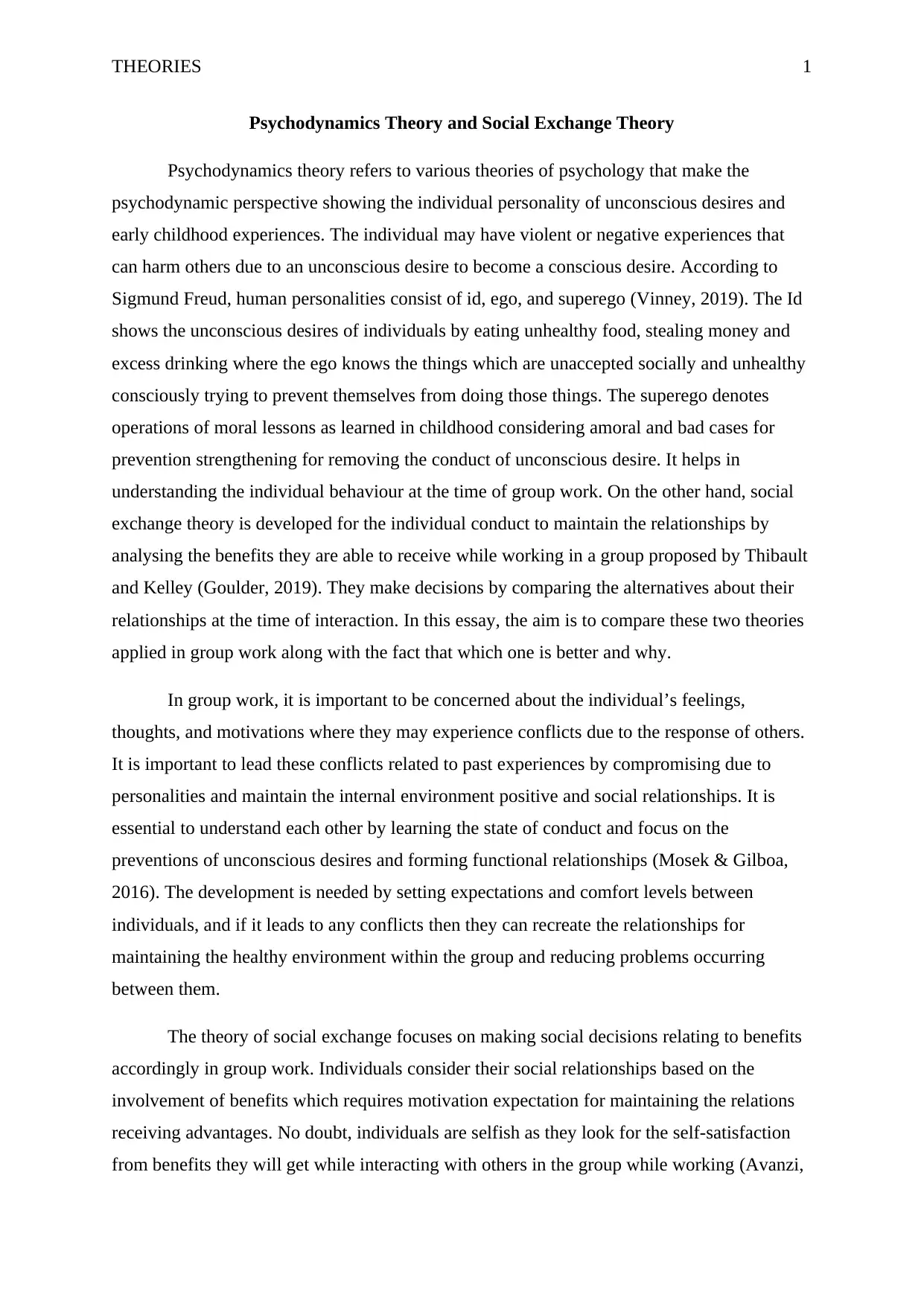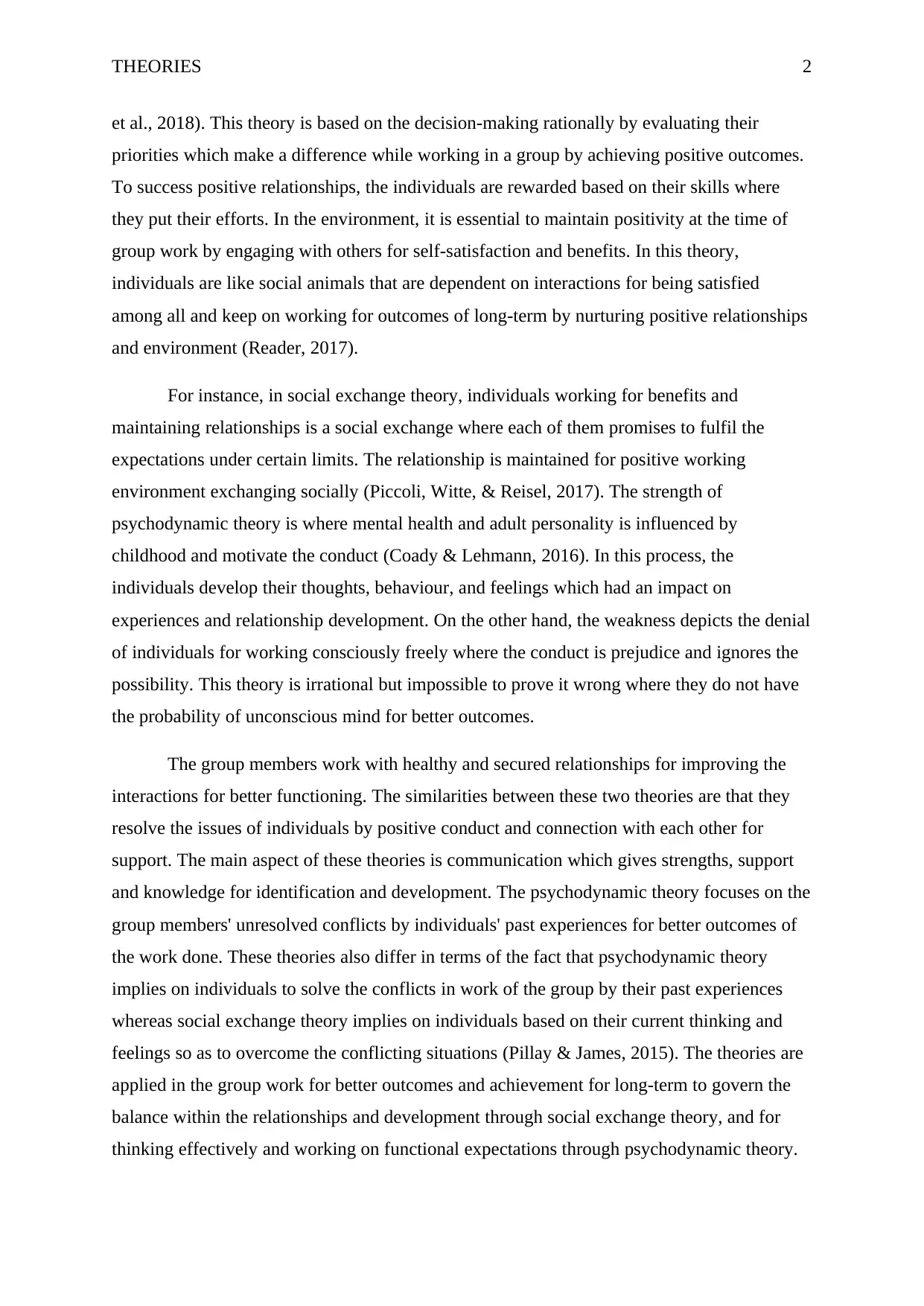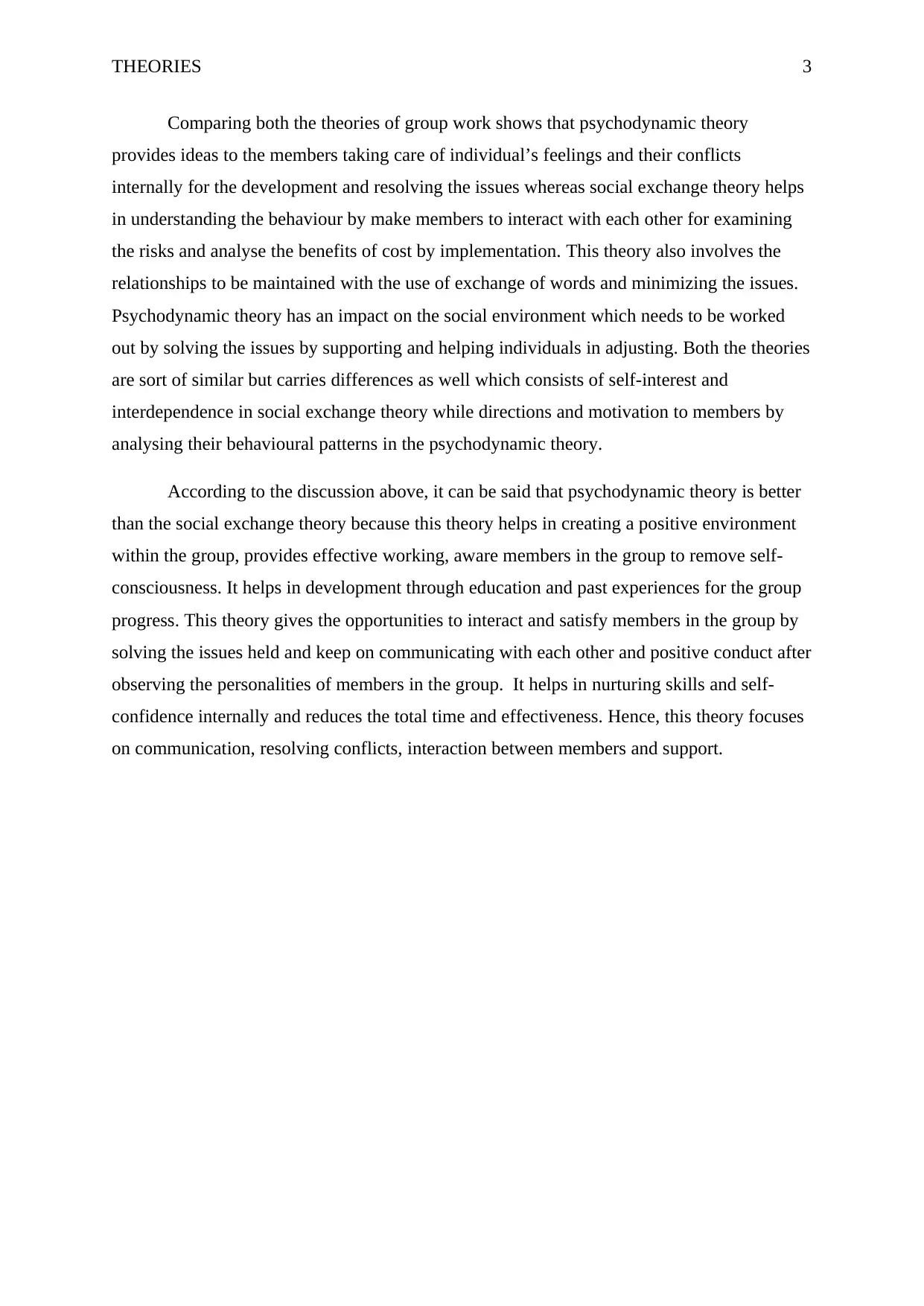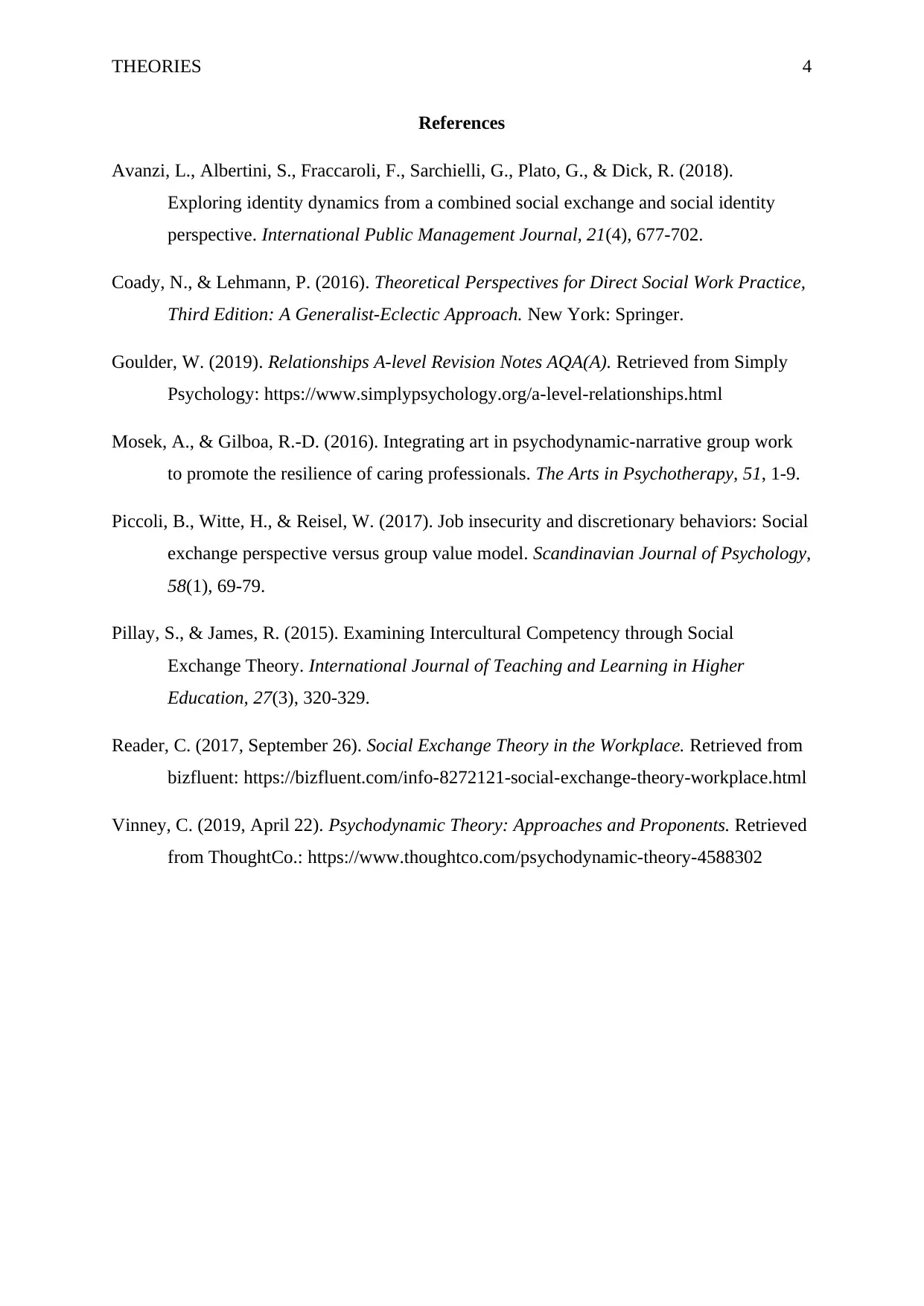Psychodynamic Theory vs. Social Exchange Theory in Group Work Analysis
VerifiedAdded on 2022/11/15
|5
|1471
|135
Essay
AI Summary
This essay delves into two prominent theories applicable to group work: psychodynamic theory and social exchange theory. Psychodynamic theory, rooted in the work of Sigmund Freud, emphasizes the influence of unconscious desires and early experiences on individual behavior and conflicts within a group. Social exchange theory, developed by Thibault and Kelley, focuses on how individuals evaluate relationships based on perceived benefits and costs. The essay compares these theories, highlighting their strengths and weaknesses in the context of group dynamics. It explores how psychodynamic theory aids in resolving conflicts stemming from past experiences and fostering a positive internal environment, while social exchange theory helps in making rational decisions and maintaining relationships based on mutual benefits. The essay concludes that psychodynamic theory is superior as it creates a positive environment within the group, promotes effective working, and encourages members to remove self-consciousness.

Running Head: THEORIES 0
Theories in group work
Student Name:
Student University:
Theories in group work
Student Name:
Student University:
Paraphrase This Document
Need a fresh take? Get an instant paraphrase of this document with our AI Paraphraser

THEORIES 1
Psychodynamics Theory and Social Exchange Theory
Psychodynamics theory refers to various theories of psychology that make the
psychodynamic perspective showing the individual personality of unconscious desires and
early childhood experiences. The individual may have violent or negative experiences that
can harm others due to an unconscious desire to become a conscious desire. According to
Sigmund Freud, human personalities consist of id, ego, and superego (Vinney, 2019). The Id
shows the unconscious desires of individuals by eating unhealthy food, stealing money and
excess drinking where the ego knows the things which are unaccepted socially and unhealthy
consciously trying to prevent themselves from doing those things. The superego denotes
operations of moral lessons as learned in childhood considering amoral and bad cases for
prevention strengthening for removing the conduct of unconscious desire. It helps in
understanding the individual behaviour at the time of group work. On the other hand, social
exchange theory is developed for the individual conduct to maintain the relationships by
analysing the benefits they are able to receive while working in a group proposed by Thibault
and Kelley (Goulder, 2019). They make decisions by comparing the alternatives about their
relationships at the time of interaction. In this essay, the aim is to compare these two theories
applied in group work along with the fact that which one is better and why.
In group work, it is important to be concerned about the individual’s feelings,
thoughts, and motivations where they may experience conflicts due to the response of others.
It is important to lead these conflicts related to past experiences by compromising due to
personalities and maintain the internal environment positive and social relationships. It is
essential to understand each other by learning the state of conduct and focus on the
preventions of unconscious desires and forming functional relationships (Mosek & Gilboa,
2016). The development is needed by setting expectations and comfort levels between
individuals, and if it leads to any conflicts then they can recreate the relationships for
maintaining the healthy environment within the group and reducing problems occurring
between them.
The theory of social exchange focuses on making social decisions relating to benefits
accordingly in group work. Individuals consider their social relationships based on the
involvement of benefits which requires motivation expectation for maintaining the relations
receiving advantages. No doubt, individuals are selfish as they look for the self-satisfaction
from benefits they will get while interacting with others in the group while working (Avanzi,
Psychodynamics Theory and Social Exchange Theory
Psychodynamics theory refers to various theories of psychology that make the
psychodynamic perspective showing the individual personality of unconscious desires and
early childhood experiences. The individual may have violent or negative experiences that
can harm others due to an unconscious desire to become a conscious desire. According to
Sigmund Freud, human personalities consist of id, ego, and superego (Vinney, 2019). The Id
shows the unconscious desires of individuals by eating unhealthy food, stealing money and
excess drinking where the ego knows the things which are unaccepted socially and unhealthy
consciously trying to prevent themselves from doing those things. The superego denotes
operations of moral lessons as learned in childhood considering amoral and bad cases for
prevention strengthening for removing the conduct of unconscious desire. It helps in
understanding the individual behaviour at the time of group work. On the other hand, social
exchange theory is developed for the individual conduct to maintain the relationships by
analysing the benefits they are able to receive while working in a group proposed by Thibault
and Kelley (Goulder, 2019). They make decisions by comparing the alternatives about their
relationships at the time of interaction. In this essay, the aim is to compare these two theories
applied in group work along with the fact that which one is better and why.
In group work, it is important to be concerned about the individual’s feelings,
thoughts, and motivations where they may experience conflicts due to the response of others.
It is important to lead these conflicts related to past experiences by compromising due to
personalities and maintain the internal environment positive and social relationships. It is
essential to understand each other by learning the state of conduct and focus on the
preventions of unconscious desires and forming functional relationships (Mosek & Gilboa,
2016). The development is needed by setting expectations and comfort levels between
individuals, and if it leads to any conflicts then they can recreate the relationships for
maintaining the healthy environment within the group and reducing problems occurring
between them.
The theory of social exchange focuses on making social decisions relating to benefits
accordingly in group work. Individuals consider their social relationships based on the
involvement of benefits which requires motivation expectation for maintaining the relations
receiving advantages. No doubt, individuals are selfish as they look for the self-satisfaction
from benefits they will get while interacting with others in the group while working (Avanzi,

THEORIES 2
et al., 2018). This theory is based on the decision-making rationally by evaluating their
priorities which make a difference while working in a group by achieving positive outcomes.
To success positive relationships, the individuals are rewarded based on their skills where
they put their efforts. In the environment, it is essential to maintain positivity at the time of
group work by engaging with others for self-satisfaction and benefits. In this theory,
individuals are like social animals that are dependent on interactions for being satisfied
among all and keep on working for outcomes of long-term by nurturing positive relationships
and environment (Reader, 2017).
For instance, in social exchange theory, individuals working for benefits and
maintaining relationships is a social exchange where each of them promises to fulfil the
expectations under certain limits. The relationship is maintained for positive working
environment exchanging socially (Piccoli, Witte, & Reisel, 2017). The strength of
psychodynamic theory is where mental health and adult personality is influenced by
childhood and motivate the conduct (Coady & Lehmann, 2016). In this process, the
individuals develop their thoughts, behaviour, and feelings which had an impact on
experiences and relationship development. On the other hand, the weakness depicts the denial
of individuals for working consciously freely where the conduct is prejudice and ignores the
possibility. This theory is irrational but impossible to prove it wrong where they do not have
the probability of unconscious mind for better outcomes.
The group members work with healthy and secured relationships for improving the
interactions for better functioning. The similarities between these two theories are that they
resolve the issues of individuals by positive conduct and connection with each other for
support. The main aspect of these theories is communication which gives strengths, support
and knowledge for identification and development. The psychodynamic theory focuses on the
group members' unresolved conflicts by individuals' past experiences for better outcomes of
the work done. These theories also differ in terms of the fact that psychodynamic theory
implies on individuals to solve the conflicts in work of the group by their past experiences
whereas social exchange theory implies on individuals based on their current thinking and
feelings so as to overcome the conflicting situations (Pillay & James, 2015). The theories are
applied in the group work for better outcomes and achievement for long-term to govern the
balance within the relationships and development through social exchange theory, and for
thinking effectively and working on functional expectations through psychodynamic theory.
et al., 2018). This theory is based on the decision-making rationally by evaluating their
priorities which make a difference while working in a group by achieving positive outcomes.
To success positive relationships, the individuals are rewarded based on their skills where
they put their efforts. In the environment, it is essential to maintain positivity at the time of
group work by engaging with others for self-satisfaction and benefits. In this theory,
individuals are like social animals that are dependent on interactions for being satisfied
among all and keep on working for outcomes of long-term by nurturing positive relationships
and environment (Reader, 2017).
For instance, in social exchange theory, individuals working for benefits and
maintaining relationships is a social exchange where each of them promises to fulfil the
expectations under certain limits. The relationship is maintained for positive working
environment exchanging socially (Piccoli, Witte, & Reisel, 2017). The strength of
psychodynamic theory is where mental health and adult personality is influenced by
childhood and motivate the conduct (Coady & Lehmann, 2016). In this process, the
individuals develop their thoughts, behaviour, and feelings which had an impact on
experiences and relationship development. On the other hand, the weakness depicts the denial
of individuals for working consciously freely where the conduct is prejudice and ignores the
possibility. This theory is irrational but impossible to prove it wrong where they do not have
the probability of unconscious mind for better outcomes.
The group members work with healthy and secured relationships for improving the
interactions for better functioning. The similarities between these two theories are that they
resolve the issues of individuals by positive conduct and connection with each other for
support. The main aspect of these theories is communication which gives strengths, support
and knowledge for identification and development. The psychodynamic theory focuses on the
group members' unresolved conflicts by individuals' past experiences for better outcomes of
the work done. These theories also differ in terms of the fact that psychodynamic theory
implies on individuals to solve the conflicts in work of the group by their past experiences
whereas social exchange theory implies on individuals based on their current thinking and
feelings so as to overcome the conflicting situations (Pillay & James, 2015). The theories are
applied in the group work for better outcomes and achievement for long-term to govern the
balance within the relationships and development through social exchange theory, and for
thinking effectively and working on functional expectations through psychodynamic theory.
⊘ This is a preview!⊘
Do you want full access?
Subscribe today to unlock all pages.

Trusted by 1+ million students worldwide

THEORIES 3
Comparing both the theories of group work shows that psychodynamic theory
provides ideas to the members taking care of individual’s feelings and their conflicts
internally for the development and resolving the issues whereas social exchange theory helps
in understanding the behaviour by make members to interact with each other for examining
the risks and analyse the benefits of cost by implementation. This theory also involves the
relationships to be maintained with the use of exchange of words and minimizing the issues.
Psychodynamic theory has an impact on the social environment which needs to be worked
out by solving the issues by supporting and helping individuals in adjusting. Both the theories
are sort of similar but carries differences as well which consists of self-interest and
interdependence in social exchange theory while directions and motivation to members by
analysing their behavioural patterns in the psychodynamic theory.
According to the discussion above, it can be said that psychodynamic theory is better
than the social exchange theory because this theory helps in creating a positive environment
within the group, provides effective working, aware members in the group to remove self-
consciousness. It helps in development through education and past experiences for the group
progress. This theory gives the opportunities to interact and satisfy members in the group by
solving the issues held and keep on communicating with each other and positive conduct after
observing the personalities of members in the group. It helps in nurturing skills and self-
confidence internally and reduces the total time and effectiveness. Hence, this theory focuses
on communication, resolving conflicts, interaction between members and support.
Comparing both the theories of group work shows that psychodynamic theory
provides ideas to the members taking care of individual’s feelings and their conflicts
internally for the development and resolving the issues whereas social exchange theory helps
in understanding the behaviour by make members to interact with each other for examining
the risks and analyse the benefits of cost by implementation. This theory also involves the
relationships to be maintained with the use of exchange of words and minimizing the issues.
Psychodynamic theory has an impact on the social environment which needs to be worked
out by solving the issues by supporting and helping individuals in adjusting. Both the theories
are sort of similar but carries differences as well which consists of self-interest and
interdependence in social exchange theory while directions and motivation to members by
analysing their behavioural patterns in the psychodynamic theory.
According to the discussion above, it can be said that psychodynamic theory is better
than the social exchange theory because this theory helps in creating a positive environment
within the group, provides effective working, aware members in the group to remove self-
consciousness. It helps in development through education and past experiences for the group
progress. This theory gives the opportunities to interact and satisfy members in the group by
solving the issues held and keep on communicating with each other and positive conduct after
observing the personalities of members in the group. It helps in nurturing skills and self-
confidence internally and reduces the total time and effectiveness. Hence, this theory focuses
on communication, resolving conflicts, interaction between members and support.
Paraphrase This Document
Need a fresh take? Get an instant paraphrase of this document with our AI Paraphraser

THEORIES 4
References
Avanzi, L., Albertini, S., Fraccaroli, F., Sarchielli, G., Plato, G., & Dick, R. (2018).
Exploring identity dynamics from a combined social exchange and social identity
perspective. International Public Management Journal, 21(4), 677-702.
Coady, N., & Lehmann, P. (2016). Theoretical Perspectives for Direct Social Work Practice,
Third Edition: A Generalist-Eclectic Approach. New York: Springer.
Goulder, W. (2019). Relationships A-level Revision Notes AQA(A). Retrieved from Simply
Psychology: https://www.simplypsychology.org/a-level-relationships.html
Mosek, A., & Gilboa, R.-D. (2016). Integrating art in psychodynamic-narrative group work
to promote the resilience of caring professionals. The Arts in Psychotherapy, 51, 1-9.
Piccoli, B., Witte, H., & Reisel, W. (2017). Job insecurity and discretionary behaviors: Social
exchange perspective versus group value model. Scandinavian Journal of Psychology,
58(1), 69-79.
Pillay, S., & James, R. (2015). Examining Intercultural Competency through Social
Exchange Theory. International Journal of Teaching and Learning in Higher
Education, 27(3), 320-329.
Reader, C. (2017, September 26). Social Exchange Theory in the Workplace. Retrieved from
bizfluent: https://bizfluent.com/info-8272121-social-exchange-theory-workplace.html
Vinney, C. (2019, April 22). Psychodynamic Theory: Approaches and Proponents. Retrieved
from ThoughtCo.: https://www.thoughtco.com/psychodynamic-theory-4588302
References
Avanzi, L., Albertini, S., Fraccaroli, F., Sarchielli, G., Plato, G., & Dick, R. (2018).
Exploring identity dynamics from a combined social exchange and social identity
perspective. International Public Management Journal, 21(4), 677-702.
Coady, N., & Lehmann, P. (2016). Theoretical Perspectives for Direct Social Work Practice,
Third Edition: A Generalist-Eclectic Approach. New York: Springer.
Goulder, W. (2019). Relationships A-level Revision Notes AQA(A). Retrieved from Simply
Psychology: https://www.simplypsychology.org/a-level-relationships.html
Mosek, A., & Gilboa, R.-D. (2016). Integrating art in psychodynamic-narrative group work
to promote the resilience of caring professionals. The Arts in Psychotherapy, 51, 1-9.
Piccoli, B., Witte, H., & Reisel, W. (2017). Job insecurity and discretionary behaviors: Social
exchange perspective versus group value model. Scandinavian Journal of Psychology,
58(1), 69-79.
Pillay, S., & James, R. (2015). Examining Intercultural Competency through Social
Exchange Theory. International Journal of Teaching and Learning in Higher
Education, 27(3), 320-329.
Reader, C. (2017, September 26). Social Exchange Theory in the Workplace. Retrieved from
bizfluent: https://bizfluent.com/info-8272121-social-exchange-theory-workplace.html
Vinney, C. (2019, April 22). Psychodynamic Theory: Approaches and Proponents. Retrieved
from ThoughtCo.: https://www.thoughtco.com/psychodynamic-theory-4588302
1 out of 5
Related Documents
Your All-in-One AI-Powered Toolkit for Academic Success.
+13062052269
info@desklib.com
Available 24*7 on WhatsApp / Email
![[object Object]](/_next/static/media/star-bottom.7253800d.svg)
Unlock your academic potential
Copyright © 2020–2025 A2Z Services. All Rights Reserved. Developed and managed by ZUCOL.





